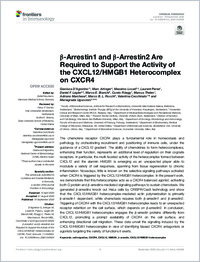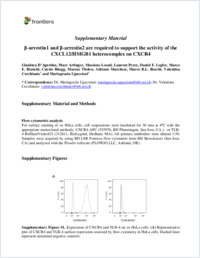β-Arrestin1 and β-Arrestin2 are required to support the activity of the CXCL12/HMGB1 heterocomplex on CXCR4
- D’Agostino, Gianluca Faculty of Biomedical Sciences, Institute for Research in Biomedicine, Università della Svizzera italiana, Bellinzona, Switzerland
- Artinger, Marc Biotechnology Institute Thurgau (BITg) at the University of Konstanz, Kreuzlingen, Switzerland
- Locati, Massimo Humanitas Clinical and Research Center IRCCS, Rozzano, Italy - Department of Medical Biotechnologies and Translational Medicine, University of Milan, Milan, Italy
- Perez, Laurent Faculty of Biomedical Sciences, Institute for Research in Biomedicine, Università della Svizzera italiana, Bellinzona, Switzerland
- Legler, Daniel F. Biotechnology Institute Thurgau (BITg) at the University of Konstanz, Kreuzlingen, Switzerland - Theodor Kocher Institute, University of Bern, Bern, Switzerland
- Bianchi, Marco E. Division of Genetics and Cell Biology, Vita-Salute San Raffaele University, Milan, Italy
- Rüegg, Curzio Department of Oncology, Microbiology and Immunology, Faculty of Science and Medicine, University of Fribourg, Fribourg, Switzerland
- Thelen, Marcus Faculty of Biomedical Sciences, Institute for Research in Biomedicine, Università della Svizzera italiana, Bellinzona, Switzerland
- Marchese, Adriano Department of Biochemistry, Medical College of Wisconsin, Milwaukee, WI, United States
- Rocchi, Marco B. L. Department of Biomolecular Sciences, Biostatistics Unit, University of Urbino, Urbino, Italy
- Cecchinato, Valentina Faculty of Biomedical Sciences, Institute for Research in Biomedicine, Università della Svizzera italiana, Bellinzona, Switzerland
- Uguccioni, Mariagrazia Faculty of Biomedical Sciences, Institute for Research in Biomedicine, Università della Svizzera italiana, Bellinzona, Switzerland - Department of Biomedical Sciences, Humanitas University, Milan, Italy
- 18.09.2020
Published in:
- Frontiers in Immunology. - 2020, vol. 11, p. 550824
English
The chemokine receptor CXCR4 plays a fundamental role in homeostasis and pathology by orchestrating recruitment and positioning of immune cells, under the guidance of a CXCL12 gradient. The ability of chemokines to form heterocomplexes, enhancing their function, represents an additional level of regulation on their cognate receptors. In particular, the multi-faceted activity of the heterocomplex formed between CXCL12 and the alarmin HMGB1 is emerging as an unexpected player able to modulate a variety of cell responses, spanning from tissue regeneration to chronic inflammation. Nowadays, little is known on the selective signaling pathways activated when CXCR4 is triggered by the CXCL12/HMGB1 heterocomplex. In the present work, we demonstrate that this heterocomplex acts as a CXCR4 balanced agonist, activating both G protein and β-arrestins-mediated signaling pathways to sustain chemotaxis. We generated β-arrestins knock out HeLa cells by CRISPR/Cas9 technology and show that the CXCL12/HMGB1 heterocomplex-mediated actin polymerization is primarily β-arrestin1 dependent, while chemotaxis requires both β- arrestin1 and β-arrestin2. Triggering of CXCR4 with the CXCL12/HMGB1 heterocomplex leads to an unexpected receptor retention on the cell surface, which depends on β-arrestin2. In conclusion, the CXCL12/HMGB1 heterocomplex engages the β-arrestin proteins differently from CXCL12, promoting a prompt availability of CXCR4 on the cell surface, and enhancing directional cell migration. These data unveil the signaling induced by the CXCL12/HMGB1 heterocomplex in view of identifying biased CXCR4 antagonists or agonists targeting the variety of functions it exerts.
- Faculty
- Faculté des sciences et de médecine
- Department
- Médecine 3ème année
- Language
-
- English
- Classification
- Biological sciences
- License
-
License undefined
- Identifiers
-
- RERO DOC 329641
- DOI 10.3389/fimmu.2020.550824
- Persistent URL
- https://folia.unifr.ch/unifr/documents/309075
Other files
Statistics
Document views: 136
File downloads:
- pdf: 218
- Supplementary material: 128

